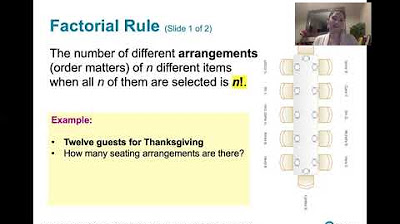Combinations
TLDRThis video script explores permutations and combinations, focusing on how to determine the number of ways 5 people can sit in 3 chairs. It explains the concept of permutations, which consider the order of seating, and then introduces combinations where the order does not matter. The script provides a formula for calculating permutations (n factorial divided by (n - k) factorial) and combinations (n choose r, also expressed as n factorial over r factorial times (n - r) factorial). The explanation uses examples to clarify the difference between counting distinct seating arrangements and selecting groups of people without regard to their positions.
Takeaways
- 😀 The video discusses permutations and combinations, specifically how to calculate the number of ways 5 people can sit in 3 chairs.
- 🧠 The formula for permutations when order matters is \( n \times (n-1) \times (n-2) \ldots \) for \( n \) objects in \( k \) positions.
- 📚 The general formula for permutations is \( \frac{n!}{(n-k)!} \), where \( n \) is the total number of objects and \( k \) is the number of positions.
- 🔢 The concept of factorials is used in permutations, denoted as \( n! \), which is the product of all positive integers up to \( n \).
- 🤔 The difference between permutations and combinations is highlighted, with permutations considering order and combinations not.
- 🔄 The script explains that for combinations, we must divide the total permutations by the number of ways the objects can be arranged within the positions.
- 📈 The formula for combinations is \( \frac{n!}{r!(n-r)!} \), where \( r \) is the number of objects chosen from \( n \), and is often written as \( n \choose r \).
- 🎲 The video uses the example of 5 people and 3 chairs to illustrate how to calculate both permutations and combinations.
- 📝 The concept of 'double counting' is mentioned, which is a common issue when calculating permutations without considering combinations.
- 📚 The script suggests that it's easier to think about the 'spots' rather than memorizing formulas for permutations and combinations.
- 🔑 The importance of understanding the origin of the formulas is emphasized, rather than just memorizing them for quick use in tests.
Q & A
How many different ways can 5 people sit in 3 chairs if the order matters?
-If the order matters, there are 5 choices for the first chair, 4 remaining choices for the second chair, and 3 choices for the third chair, resulting in a total of 5 * 4 * 3 = 60 different permutations.
What is the mathematical representation of the number of ways 5 people can sit in 3 chairs?
-The mathematical representation is 5! / (5 - 3)!, which simplifies to 5! / 2! = (5 * 4 * 3 * 2 * 1) / (2 * 1) = 60.
What does the term 'factorial' represent in the context of permutations?
-The term 'factorial' represents the product of an integer and all the integers below it, e.g., 5! = 5 * 4 * 3 * 2 * 1.
How is the number of permutations related to the number of combinations when the order does not matter?
-When the order does not matter, the number of combinations is calculated by taking the number of permutations and dividing it by the number of ways the objects can be arranged within the subset, which is r! in this case.
What is the general formula for calculating the number of ways n things can be placed into k positions?
-The general formula is n! / (n - k)!, where n is the number of things and k is the number of positions.
What is a combination in the context of permutations?
-A combination is a selection of items where the order of selection does not matter. It's a permutation where the arrangement within the subset is not considered distinct.
How many permutations are there for 3 people sitting in 3 chairs?
-There are 3! = 3 * 2 * 1 = 6 permutations for 3 people sitting in 3 chairs.
What is meant by 'double counting' in the context of permutations and combinations?
-Double counting occurs when the same combination is counted more than once due to different arrangements being considered distinct.
How can you calculate the number of combinations of 5 things taken 3 at a time?
-You calculate it by using the formula n! / (r! * (n - r)!), which in this case is 5! / (3! * (5 - 3)!) = 10.
What is the binomial coefficient, and how is it represented?
-The binomial coefficient, often written as 'n choose r', is a way to calculate the number of combinations and is represented as n! / (r! * (n - r)!).
How many different groups of 3 can be selected from 5 people?
-Using the combination formula, there are 10 different groups of 3 that can be selected from 5 people.
Outlines
🧑💼 Understanding Permutations and Factorials
This paragraph explains the concept of permutations and factorials in the context of seating arrangements. It begins with a practical example of how 5 people can be seated in 3 chairs, illustrating the basic principle of permutations where order matters. The explanation includes the formula for calculating permutations when placing 'n' items into 'k' positions, which is 'n! / (n-k)!'. The paragraph also introduces the concept of factorials and how they relate to the number of ways 'n' items can be arranged in 'k' positions. The presenter emphasizes the importance of understanding the formula by relating it back to the initial example of people and chairs, and suggests that this method of thinking about permutations can be helpful for memorization and application in various scenarios.
🔄 Transitioning from Permutations to Combinations
The second paragraph delves into the difference between permutations and combinations, focusing on the scenario where the order of arrangement does not matter. The presenter clarifies that a combination is a type of permutation where the sequence is irrelevant. Using the same example of 5 people and 3 chairs, the paragraph explains how to calculate the number of combinations by considering the different ways to choose a subset of people without regard to their seating order. The explanation involves dividing the total permutations by the number of ways the chosen people can be arranged in the seats, which is represented by 'r!'. The presenter provides a step-by-step breakdown of the formula for combinations, 'n! / (r! * (n-r)!)', and illustrates it with a numerical example, emphasizing the importance of understanding the rationale behind the formula rather than just memorizing it.
🔢 Calculating Combinations with Examples
In the final paragraph, the presenter provides a detailed example to calculate the number of ways to choose groups of 3 from a set of 5, using the combination formula derived in the previous paragraph. The explanation walks through the process of simplifying the factorial expressions to arrive at the final answer. The presenter calculates '5! / (3! * (5-3)!)' and simplifies it step by step, demonstrating the cancellation of terms and the final division to obtain the number of combinations. The paragraph concludes with the result of 10 possible ways to form groups of 3 from 5 people, reinforcing the concept of combinations and providing a clear example of how to apply the formula in practice.
Mindmap
Keywords
💡Permutations
💡Factorial
💡Combinations
💡Binomial Coefficient
💡Subset
💡Order
💡Positions
💡Musical Chairs
💡Double Counting
💡Polynomial Expansion
💡Rearrange
Highlights
Explained how many different ways 5 people can sit in 3 chairs.
Total permutations are calculated as 5 times 4 times 3.
Permutations can also be expressed as 5 factorial over 2 factorial.
The concept of 2 factorial is derived from the difference between 5 and 3.
General formula for permutations of n things into k positions is n factorial over (n minus k) factorial.
Assumption made that k is less than or equal to n for the formula to hold.
Illustrated the concept of permutations with an example of 5 people and their seating arrangements.
Differentiated between permutations and combinations based on the order of arrangement.
Explained that combinations do not consider order, focusing on the selection of items.
Described how to calculate combinations by dividing permutations by the number of arrangements.
Provided the formula for combinations as n factorial over (r factorial times (n minus r) factorial).
Highlighted the importance of understanding the origin of the formula for combinations.
Discussed the application of combinations in selecting groups from a larger set.
Clarified the difference between permutations and combinations with an example of seating arrangements.
Introduced the concept of 'n choose r' or binomial coefficient in the context of combinations.
Explained the mathematical process of calculating combinations with an example of selecting 3 people from 5.
Concluded with the result that there are 10 possible ways to form groups of 3 from 5 people.
Transcripts
Browse More Related Video

Permutations

Statistics Lecture 4.7: Fundamental Counting Rule, Permutations and Combinations

4.4.5 Counting - Permutations and Combinations and the Combinations Rule

4.4.2 Counting - The Factorial Rule

4.4.3 Counting - Permutations and Combinations, and the Permutation Rule

4.4.0 Counting - Lesson Overview, Learning Outcomes, and Key Concepts
5.0 / 5 (0 votes)
Thanks for rating: